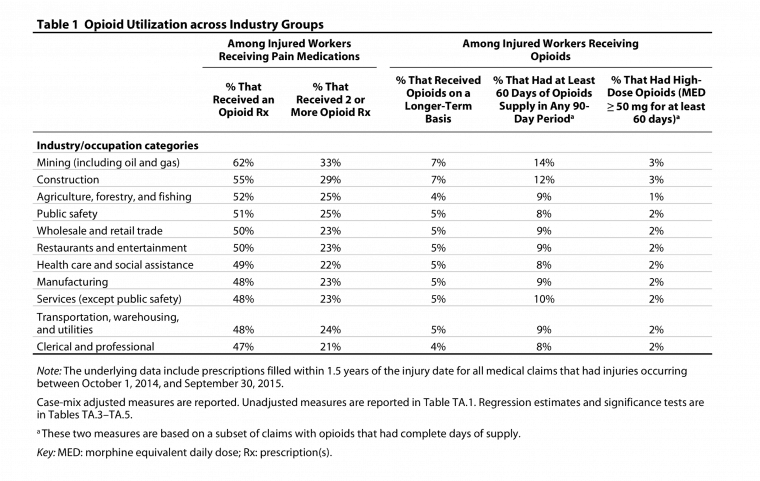Injured miners and construction workers are in the occupations most likely to receive an opioid prescription, the study shows. Injured workers living in “rural” or “very rural” areas were up to 25% more likely than urban injured workers to receive opioid painkillers.
Injured workers in rural areas are more likely to receive prescriptions for opioids, a new study shows.
The study by the Workers’ Compensation Research Institute (WCRI) looked at how a worker’s age, injury, industry and location impacted how likely they were to be given prescriptions for opioids. WCRI is an independent, non-profit research institute that looks at workers’ compensation policies and practices to provide information to the workers’ compensation industry.
WCRI looked at 1.4 million post-injury pain medication prescriptions in 27 states from October, 2014 to September 30, 2015. All prescriptions were issued before the Centers for Disease Control issued tighter guidelines for opioid prescriptions in 2016.
(The states studied were Arkansas, California, Connecticut, Delaware, Florida, Georgia, Illinois, Indiana, Iowa, Kansas, Kentucky, Louisiana, Maryland, Massachusetts, Michigan, Minnesota, Missouri, Nevada, New Jersey, New York, North Carolina, Pennsylvania, South Carolina, Tennessee, Texas, Virginia and Wisconsin.)
Injured workers in rural or very rural counties were found to be more likely to receive at least one opioid prescription. The study used the Urban-Rural Continuum Codes to determine whether or not an area was rural. According to those codes, rural areas include non-metropolitan counties adjacent to metro areas or counties where population size was greater than 20,000; and very rural areas were those where population size was less than 20,000.
According to the study, two thirds of injured patients in rural and very rural areas received at least one opioid prescription, where one third received two or more prescriptions. But those in rural areas were only slightly more likely to stay on the prescriptions longer, with 10 percent of those injured workers on opioids having prescriptions for 60 days or more, as compared to 9 percent in rural areas.
“In this study we tried to identify factors that were associated with higher and lower opioid dispensing rates and we observed higher opioid dispensing rates in rural counties compared to urban counties,” said Dr. Vennela Thumula, the study’s author, said in an interview with Daily Yonder. “Similar results were reported in a CDC study looking at the general population.”
Thumula said the study did not address causality, but that geographic differences can affect opioid prescription rates.
“It is beyond the scope of our study to establish causality,” Thumula said. “That said, geographic differences in medical practice and health care delivery systems and differences in socioeconomic factors such as education level, socioeconomic status, labor force participation, and other quality of life indicators, may play a role… We found similar results, i.e., higher opioid dispensing rates in rural counties compared to urban counties, even in a study we published last year which focused on one state, Kentucky. It is interesting that similar direction of results was seen in this study even after controlling for local opioid dispensing rate quartiles.”
Previous WCRI studies found that workers in some states – such as Louisiana, California, Georgia, North Carolina, Pennsylvania, South Carolina and Texas, are more likely to receive opioids and to get prescriptions for longer periods of time. Between 1 in 10 and 1 in 12 injured workers with opioid prescriptions in those states were identified as having “long-term” prescriptions, or prescriptions for more than 60 days’ supply of the drug in any 90-day period.
The study also found that employees at small companies were more likely to be given prescriptions for opioids. Injured employees who worked for small businesses, or those having a payroll of less than $20 million, were also more likely to be prescribed opioids. The study found that 54 percent of injured employees of companies with payrolls between $1 million and $4 million were given at least one prescription for opioids, compared to 47 percent of those employed by companies with payrolls between $20 million to $80 million. Injured workers at those small companies were also more likely to have two or more opioid prescriptions, and to have long term prescriptions.
Injured workers in certain industries, like mining and construction, were more likely to receive opioid prescriptions, as were workers between the ages of 40 and 60, and workers who sustained fractures, carpel tunnel syndrome or neurological spine pain, were more likely to receive at least one opioid prescription.
Thumula said the study looked at patterns WCRI had seen in previous studies.
“WCRI has been examining opioid utilization patterns across states and over time for many years,” Thumula said. “Over these years we learned that workers in certain industries, workers sustaining certain injuries were more likely to receive opioids. This study was an attempt to quantify this variation.”
But in general, Thumula said, opioid prescriptions are declining.
“In previous WCRI studies, we found substantial decreases in opioids dispensed to injured workers,” she said. “Also, fewer injured workers received opioids on a longer-term basis in recent years. We haven’t specifically examined whether workers had a diagnosis of opioid use disorders but a decrease in opioid prescriptions, especially on a longer-term basis may have impacted the rate of opioid dependency.”
While WCRI does not make any policy recommendations, the information may be of use to those who do, WCRI officials said.
“This study can help public officials and other stakeholders better predict which injured workers are more or less likely to receive opioids,” said Dr. John Ruser, WCRI’s president and CEO. “For example, this study finds that injured workers in certain industries are more likely to receive opioids on a chronic basis. This information might be useful in setting priorities for targeting special interventions to reduce inappropriate opioid prescriptions.”
This article was originally published by Daily Yonder.





